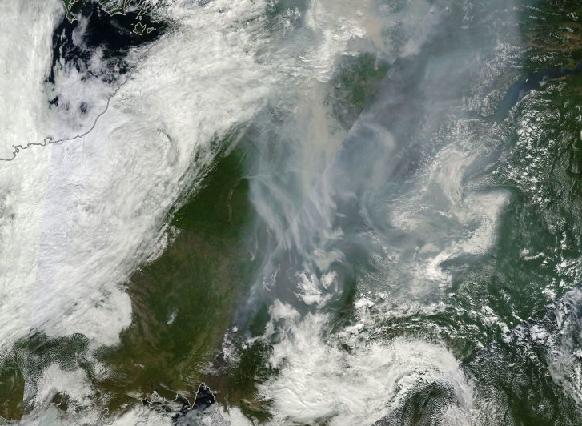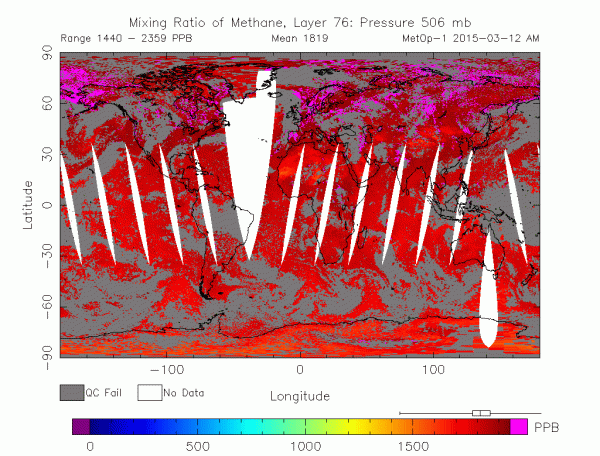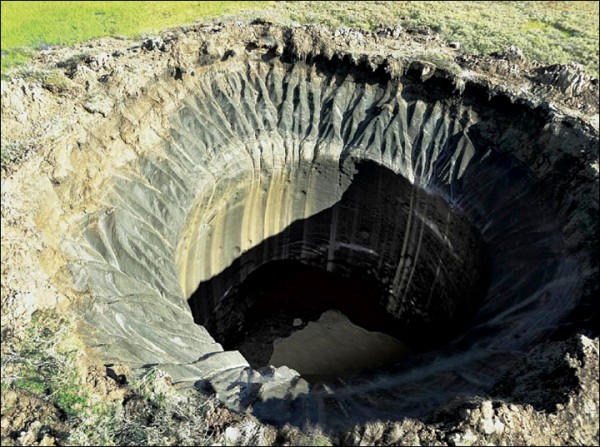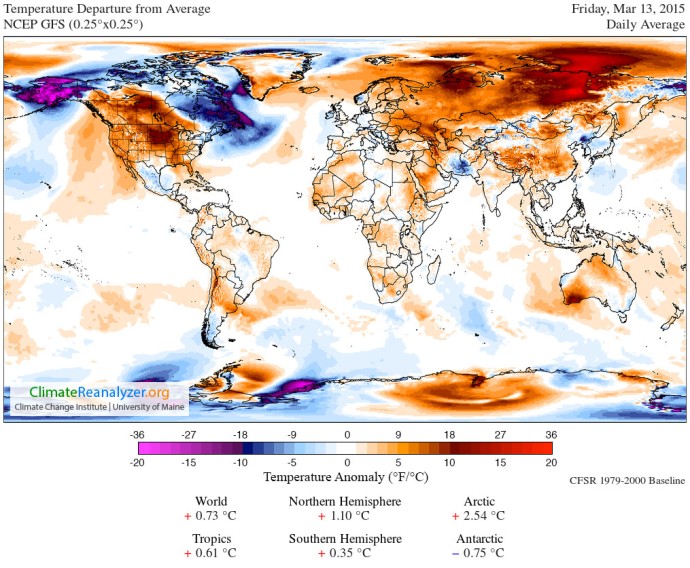Unconfirmed
Reports of Giant, 1 Kilometer, Methane Crater Found in Siberia
13
March, 2015
“We
have just learnt that in Yakutia, new information has emerged about a
giant crater one kilometre (0.6 miles) in diameter,” the deputy
director of the Oil and Gas Research Institute of the Russian Academy
of Sciences, Vasily Bogoyavlensky, told AFP.
*
* * *
Sometimes,
when writing a blog about the latest cutting edge climate science,
you feel like you’re tracing the footprints of a Godzilla-like
monster. One
of Steven Pascala’s proverbial ‘climate monsters in the
closet.’ This
week has been filled with those days. Days when you get the sense
that one might have gotten out.
(Arctic methane overburden continues. NOAA’s IASI METOP sensor again shows elevated methane readings today peaking at 2349 ppb [average 1819 ppb] with highest levels [pink] concentrated over the Arctic and upper Northern Hemisphere Latitudes in the 18,000 foot altitude layer. Image source: METOP.)
Just
this Monday, I
penned a narrative analysis of the signs of methane and carbon store
destabilization in the Arctic, the various risks involved, and the
potential that the methane blow holes we’ve been witnessing may be
linked to giant craters previously found on the ocean floor.
Craters ranging from 250 meters to seven miles across.
Yesterday,
the deputy director of the Oil and Gas Research Institute of the
Russian Academy of Sciences (RAS) issued the above statement to the
Associated Press, in which he described a newly discovered 1000 meter
crater in the Yakutia region. The statement was then circulated in
the Guardian and
at Physics.org.
(The Yamal Crater, as seen above, would be miniscule compared to a Yakutia Crater reported by Russian Scientists yesterday. Image source: The Siberian Times via Vasily Bogoyavlensky.)
The
statement was a few paragraphs down in a report that announced a
likely link between climate change and the seven other methane
craters discovered throughout northern Siberia over the past eight
months. It provided no additional context, simply reporting a massive
crater. One that, if it proves to be a confirmed recent event, could
completely reshape the way we look at how thawing lands and sea beds
impact sequestered methane and carbon stores in the Arctic.
But
there is still quite a lot we do not know about this crater,
including its potential age.
The
first Crater, discovered in Yamal was just a bit more than 100 feet
across and 220 feet in depth. Of all the craters discovered up until
yesterday, it was the largest. According to reports from the Russian
Academy of Sciences and from the Russian Center of Arctic
Exploration, often through the Siberian Times, these craters
were likely
caused by explosions of methane under high pressure through a top
layer of melting permafrost.
The reports identified destabilized relic methane hydrate as a likely
source of the eruptions, which the scientists are now stating are
somewhat similar to volcanic explosions.
(Global temperature anomalies from the University of Maine’s Climate Reanalyzer today shows extraordinary temperature departures in the range of +20 C above average over Yakutia, Russia. A region that has experienced an extraordinary pace of warming coincident with raging polar amplification. Data Source: Global Forecast System Model.)
The
new crater is said to be located in a region of Yakutia, which is a
Siberian province many hundreds of miles east of the Yamal Crater.
Yakutia hosts some of the densest permafrost deposits in the Arctic.
It has also experienced extraordinarily rapid warming similar to the
Yamal increase of 2 degrees Celsius in just 14 years. Over coming
years, the pace of warming is predicted to be equally rapid. Climate
models for the region indicate as much as 8 degrees Celsius warming
through the end of this Century.
The result is that we see Yakutia, as much of Siberia, in a state of
very rapid and destabilizing climate change.
Stresses
to permafrost due to this raging rate of warming are extraordinary
and involve not only permafrost melt and subsidence but also horrific
wildfires that individually burn hundreds of square miles. These
enormous wildfires are not normal, garden variety infernos. They
often alter the weather, forming enormous fire thunderstorms
overhead. They have been reported to burn so hot as to ignite the
soil itself, incinerating everything to at least three feet of depth.
Near surface methane pockets also likely become involved in these
fires and the peat-like structure of the permafrost, once thawed, can
result in continued basement smoldering long after the surface fire
is extinguished.

(Massive wildfires belching out immense plumes of smoke on July 23, 2014 in the Yakutia region of Russia. For reference, bottom edge of frame is about 2000 miles. Image source:LANCE-MODIS.)
These
massive, fearsome fires are anything but normal. They are directly
linked to the rate of warming, permafrost thaw, and carbon store
release in Arctic Siberia. And it appears that for Yakutia, which has
seen some of the worst of these fires, a rather large scale methane
eruption risk — enough to produce 1000 meter craters — may also
now be involved as well.
Links:
Hat
tip to Colorado Bob
Hat
tip to Ouse, MD
Scientific
hat tip to The Russian Academy of Sciences






No comments:
Post a Comment
Note: only a member of this blog may post a comment.